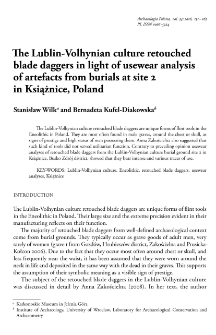
Object
Title: The Lublin-Volhynian culture retouched blade daggers in light of usewear analysis of artefacts from burials at site 2 in Książnice, Poland
Subtitle:
Archaeologia Polona Vol. 54 (2016)
Publisher:
Institute of Archaeology and Ethnology Polish Academy of Sciences
Place of publishing:
Description:
Type of object:
Abstract:
The Lublin-Volhynian culture retouched blade daggers are unique forms of flint tools in the Eneolithic in Poland. They are most often found in male graves, around the chest or skull, as signs of prestige and high status of men possessing them. Anna Zakościelna also suggested that such kind of tools did not served utilitarian function. Contrary to prevailing opinion usewear analyses of retouched blade daggers from the Lublin-Volhynian culture burial ground site 2 in Książnice, Busko Zdrój district, showed that they bear intense and various traces of use.
References:
Beugnier, V. and Plisson, H. 2000. Les poignards en silex: du Grand-Pressigny: fonction de signe et fonction d’usage. In. P. Bodu and C. Constantin (eds), Approches fonctionelles en préhistoire. Actes du XXVe Congrès Préhistorique de France (24-26 novembre 2000, Nanterre), 139–154. Paris.
van Gijn, A.L., 2010. Flint in focus. Lithic Biographies in the Neolithic and Bronze Age. Leiden.
Gróżdź, W., Migal, W. and Pyżewicz, K. 2015. Bifacial flint daggers from the Early Bronze Age in Volhynia - Lesser Poland. In B.V. Eriksen and K. Frieman (eds), Flint daggers in prehistoric Europe, 116–132. Oxbow.
Kufel-Diakowska, B., Wiśniewski, A. and Chłoń, M. 2016. Wyroby ze skał krzemionkowych w pochówkach kultury jordanowskiej stanowiska Domasław, Archeologiczne Zeszyty Autostradowe, 18, Badania na autostradzie A-4, part XIV. Wrocław.
Skakun, N. 2008. Comprehensive analysis of prehistoric tools and its relevance for paleo-economic reconstructions. In L. Longo and N. Skakun (eds), Prehistoric Technology 40 years later: Functional Studies and the Russian Legacy, Proceedings of the International Congress Verona (Italy), 20-23 April 2005, 358–364. Oxford.
Stapert, D. and Johansen, L. 1999. Making fire in the Stone Age: Flint and pyrite, Geologie en Mijnbouw 78: 147–164.
Wilk, S. 2006. Graves of the Lublin-Volhynian culture at site 2 in Książnice, district of Busko Zdrój. 2004 exploration season. Sprawozdania Archeologiczne 58: 247–270.
Wilk, S. 2014. An elite burial from the Copper Age: Grave 8 at the cemetery of the Lublin-Volhynian culture at Site 2 in Książnice, the Świętokrzyskie province. Analecta Archaeologica Ressoviensia 9: 209–258.
Zakościelna, A. 2006. Flint inventory of grave 5 of the Lublin-Volhynia culture on site 2 in Książnice, Busko Zdrój district. Sprawozdania Archeologiczne 58: 271–291.
Zakościelna, A. 2008. Wiórowce-sztylety jako atrybuty pozycji społecznej mężczyzn kultury lubelsko--wołyńskiej. In J. Bednarczyk, J. Czebreszuk, P. Makarowicz and M. Szmyt (eds), Na pograniczu światów. Studia z pradziejów międzymorza bałtycko- pontyjskiego ofiarowane Profesorowi Aleksandrowi Kośko w 60. rocznicę urodzin, 577–591. Poznań.
Zakościelna, A. 2010. Studium obrządku pogrzebowego kultury lubelsko-wołyńskiej. Lublin.
Zakościelna, A. and Prusicka-Kołcon, E. 2006. Grób kultury lubelsko-wołyńskiej ze stanowiska 1 w Gozdowie, pow. hrubieszowski. Archeologia Polski Środkowowschodniej 8: 243–251.
Relation:
Volume:
Start page:
End page:
Detailed Resource Type:
Format:
Resource Identifier:
oai:rcin.org.pl:63440 ; 0066-5924
Source:
IAiE PAN, call no. P 357 ; IAiE PAN, call no. P 358 ; IAiE PAN, call no. P 356 ; click here to follow the link
Language:
Rights:
Terms of use:
Copyright-protected material. May be used within the limits of statutory user freedoms
Digitizing institution:
Institute of Archaeology and Ethnology of the Polish Academy of Sciences
Original in:
Library of the Institute of Archaeology and Ethnology of the Polish Academy of Sciences
Access:
Object collections:
- Digital Repository of Scientific Institutes > Partners' collections > Institute of Archeology and Ethnology PAS > Institute Publications
- Digital Repository of Scientific Institutes > Partners' collections > Institute of Archeology and Ethnology PAS > Institute Publications > Current Journals
- Digital Repository of Scientific Institutes > Literature > Journals/Articles
- Digital Repository of Scientific Institutes > Partners' collections > Institute of Archeology and Ethnology PAS > Institute Publications > Current Journals > Archaeologia Polona
Last modified:
Mar 3, 2023
In our library since:
Oct 27, 2017
Number of object content downloads / hits:
162
All available object's versions:
https://rcin.org.pl./publication/83018
Show description in RDF format:
Show description in RDFa format:
Show description in OAI-PMH format:
Objects Similar
Wilk, Stanislaw
Kufel-Diakowska, Bernadeta Wilk, Stanisław
Wilk, Stanislaw
Makowicz-Poliszot, Danuta
Haduch, Elżbieta (1949– )
Haduch, Elzbieta
Zakościelna, Anna
Kadrow, Sławomir (1956– )

 INSTYTUT ARCHEOLOGII I ETNOLOGII POLSKIEJ AKADEMII NAUK
INSTYTUT ARCHEOLOGII I ETNOLOGII POLSKIEJ AKADEMII NAUK
 INSTYTUT BADAŃ LITERACKICH POLSKIEJ AKADEMII NAUK
INSTYTUT BADAŃ LITERACKICH POLSKIEJ AKADEMII NAUK
 INSTYTUT BADAWCZY LEŚNICTWA
INSTYTUT BADAWCZY LEŚNICTWA
 INSTYTUT BIOLOGII DOŚWIADCZALNEJ IM. MARCELEGO NENCKIEGO POLSKIEJ AKADEMII NAUK
INSTYTUT BIOLOGII DOŚWIADCZALNEJ IM. MARCELEGO NENCKIEGO POLSKIEJ AKADEMII NAUK
 INSTYTUT BIOLOGII SSAKÓW POLSKIEJ AKADEMII NAUK
INSTYTUT BIOLOGII SSAKÓW POLSKIEJ AKADEMII NAUK
 INSTYTUT CHEMII FIZYCZNEJ PAN
INSTYTUT CHEMII FIZYCZNEJ PAN
 INSTYTUT CHEMII ORGANICZNEJ PAN
INSTYTUT CHEMII ORGANICZNEJ PAN
 INSTYTUT FILOZOFII I SOCJOLOGII PAN
INSTYTUT FILOZOFII I SOCJOLOGII PAN
 INSTYTUT GEOGRAFII I PRZESTRZENNEGO ZAGOSPODAROWANIA PAN
INSTYTUT GEOGRAFII I PRZESTRZENNEGO ZAGOSPODAROWANIA PAN
 INSTYTUT HISTORII im. TADEUSZA MANTEUFFLA POLSKIEJ AKADEMII NAUK
INSTYTUT HISTORII im. TADEUSZA MANTEUFFLA POLSKIEJ AKADEMII NAUK
 INSTYTUT JĘZYKA POLSKIEGO POLSKIEJ AKADEMII NAUK
INSTYTUT JĘZYKA POLSKIEGO POLSKIEJ AKADEMII NAUK
 INSTYTUT MATEMATYCZNY PAN
INSTYTUT MATEMATYCZNY PAN
 INSTYTUT MEDYCYNY DOŚWIADCZALNEJ I KLINICZNEJ IM.MIROSŁAWA MOSSAKOWSKIEGO POLSKIEJ AKADEMII NAUK
INSTYTUT MEDYCYNY DOŚWIADCZALNEJ I KLINICZNEJ IM.MIROSŁAWA MOSSAKOWSKIEGO POLSKIEJ AKADEMII NAUK
 INSTYTUT PODSTAWOWYCH PROBLEMÓW TECHNIKI PAN
INSTYTUT PODSTAWOWYCH PROBLEMÓW TECHNIKI PAN
 INSTYTUT SLAWISTYKI PAN
INSTYTUT SLAWISTYKI PAN
 SIEĆ BADAWCZA ŁUKASIEWICZ - INSTYTUT TECHNOLOGII MATERIAŁÓW ELEKTRONICZNYCH
SIEĆ BADAWCZA ŁUKASIEWICZ - INSTYTUT TECHNOLOGII MATERIAŁÓW ELEKTRONICZNYCH
 MUZEUM I INSTYTUT ZOOLOGII POLSKIEJ AKADEMII NAUK
MUZEUM I INSTYTUT ZOOLOGII POLSKIEJ AKADEMII NAUK
 INSTYTUT BADAŃ SYSTEMOWYCH PAN
INSTYTUT BADAŃ SYSTEMOWYCH PAN
 INSTYTUT BOTANIKI IM. WŁADYSŁAWA SZAFERA POLSKIEJ AKADEMII NAUK
INSTYTUT BOTANIKI IM. WŁADYSŁAWA SZAFERA POLSKIEJ AKADEMII NAUK


































